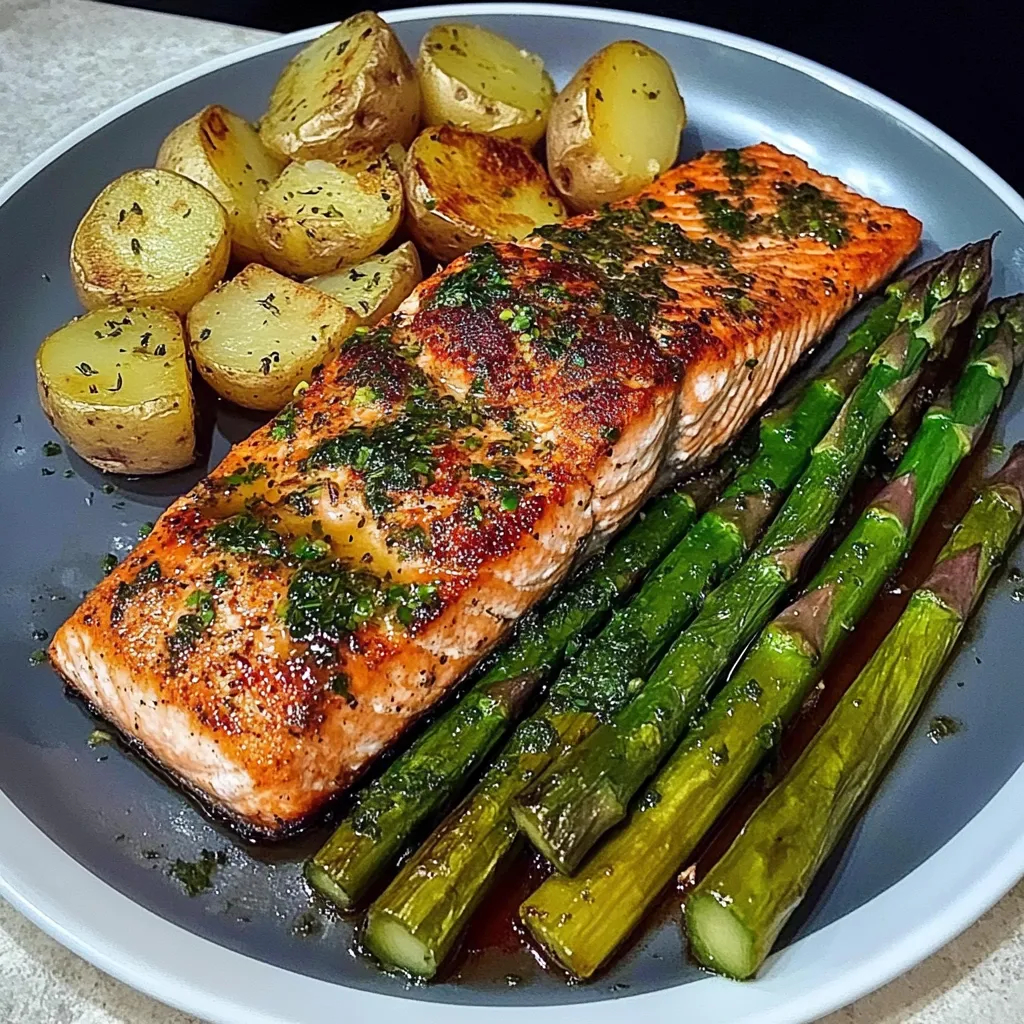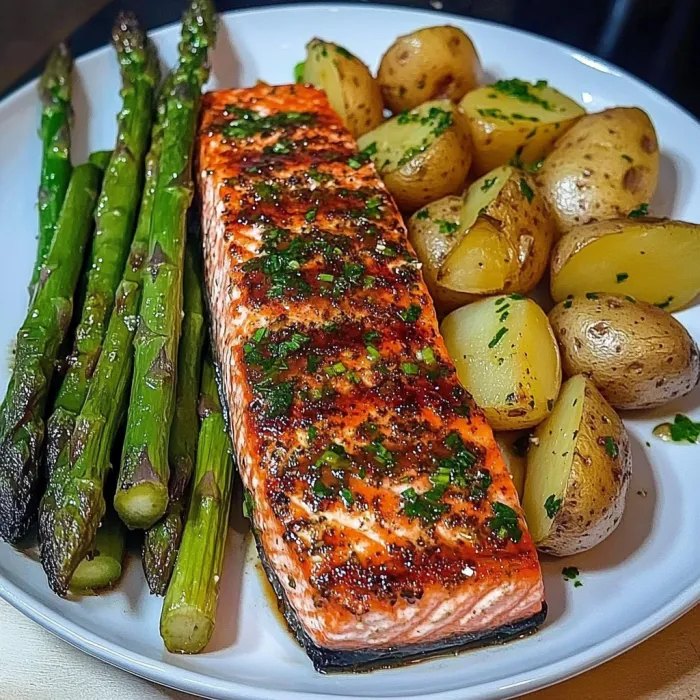 Save
Save
This garlic herb salmon with roasted potatoes and asparagus creates a complete sheet pan dinner that's both impressive and incredibly simple. The combination of perfectly cooked salmon with crispy potatoes and tender asparagus makes for a balanced meal that feels restaurant-worthy but comes together in under 35 minutes.
I discovered this recipe when looking for ways to incorporate more omega-3s into our family meals. What started as a health-conscious choice quickly became our go-to impressive yet effortless dinner for both busy weeknights and dinner parties.
Ingredients
- Fresh salmon fillets look for firm, bright pink flesh with a mild ocean scent. Wild-caught offers more flavor but farm-raised works well too
- Extra virgin olive oil provides a fruity base for both marinades. Use high-quality oil for best results
- Fresh lemon juice brightens the entire dish. Always use freshly squeezed rather than bottled
- Garlic cloves add aromatic depth. Freshly minced delivers stronger flavor than pre-minced options
- Paprika adds subtle smokiness and beautiful color to the salmon
- Baby potatoes their small size ensures they cook quickly and develop crispy exteriors
- Fresh asparagus choose bundles with tight, compact tips and slim stalks for tenderness
- Fresh herbs particularly parsley brings brightness to balance the rich salmon
Step-by-Step Instructions
- Prep the Potatoes
- Halve baby potatoes and toss thoroughly with olive oil ensuring each piece is coated. Season generously with salt and pepper as potatoes need substantial seasoning. Arrange in a single layer on a baking sheet with cut sides down for maximum caramelization. Roast at 400°F for 20 minutes until edges are golden and interiors are tender.
- Marinate the Salmon
- While potatoes roast whisk olive oil lemon juice minced garlic paprika and dried herbs in a small bowl until emulsified. Pat salmon fillets dry with paper towels to ensure the marinade adheres properly. Brush marinade liberally over both sides of salmon allowing the flavors to penetrate for at least 5 minutes before cooking.
- Cook the Salmon
- Heat a large skillet over medium heat until hot but not smoking. Place salmon skin side down if skin is attached and cook undisturbed for 4 minutes to crisp the skin. Flip gently using a fish spatula and cook an additional 3 to 5 minutes depending on thickness. The salmon should flake easily but remain slightly translucent in the center for optimal moisture.
- Prepare the Asparagus
- In the same skillet after removing salmon add a touch more olive oil and minced garlic sautéing for just 30 seconds until fragrant. Add trimmed asparagus and toss to coat in the garlic oil. Cook for 3 to 5 minutes depending on thickness rotating occasionally until bright green and tender crisp. Season with salt and pepper just before removing from heat.
 Save
Save
The paprika is actually my secret ingredient here. I discovered its transformative effect on salmon during a cooking class in Barcelona where the chef taught us that a pinch of quality Spanish paprika enhances the natural flavors of seafood without overpowering it. Since then I never make salmon without it.
Make-Ahead Options
This dish works beautifully for meal prep. You can marinate the salmon up to 12 hours ahead in the refrigerator which actually intensifies the flavor. The potatoes can be parboiled and refrigerated the day before then finished in the oven while the salmon cooks. Asparagus is best prepared just before serving but will hold up for reheating if necessary.
Variations To Try
For a Mediterranean twist add halved cherry tomatoes and pitted Kalamata olives to the asparagus during the last minute of cooking. The tomatoes will burst slightly creating a light sauce that complements the salmon beautifully.
Consider swapping the asparagus for green beans broccoli or Brussels sprouts depending on seasonal availability. Each vegetable brings its own character to the dish while maintaining the ease of preparation.
For a dairy-free creamy finish top the salmon with a quick avocado cream by blending ripe avocado with lemon juice and herbs until smooth.
Serving Suggestions
For an elegant presentation arrange the components in distinct sections on white plates with the salmon centered and vegetables artfully arranged on either side. A lemon wedge adds both color and functionality.
This meal pairs beautifully with a crisp Sauvignon Blanc or Pinot Grigio. For non-alcoholic options a sparkling water with cucumber and mint complements the fresh flavors perfectly.
Recipe FAQs
- → How do I know when the salmon is cooked properly?
Salmon is properly cooked when it flakes easily with a fork but is still moist inside. The center should be slightly translucent and the internal temperature should reach 145°F (63°C). For this recipe, cooking 4-5 minutes per side typically achieves perfect doneness, but this can vary depending on the thickness of your fillets.
- → Can I use dried herbs instead of fresh?
Yes, you can substitute dried herbs for fresh in this dish. As a general rule, use one-third the amount of dried herbs compared to fresh (e.g., 1 teaspoon dried parsley instead of 1 tablespoon fresh). The recipe already calls for dried parsley for the salmon, but you can use 1 teaspoon dried parsley for the potatoes if fresh isn't available.
- → How do I properly trim asparagus?
To trim asparagus, hold each spear by the ends and gently bend until it snaps naturally. The break point separates the tender top from the woody bottom. Alternatively, you can line up all spears and cut off the bottom inch or two with a knife. For thicker asparagus, you may also want to peel the lower half of the stems with a vegetable peeler for more tender results.
- → Can I make this dish ahead of time?
While this dish is best served fresh, you can prepare components ahead of time. The potatoes can be roasted in advance and reheated. The salmon and asparagus are best cooked just before serving, but the garlic-herb mixture for the salmon can be prepared up to 24 hours ahead and refrigerated in an airtight container.
- → What can I substitute for asparagus if it's not in season?
If asparagus isn't available, good substitutes include green beans, broccoli, or zucchini. For green beans or broccoli, steam or blanch them first, then finish in the skillet with garlic and olive oil. Zucchini can be directly sautéed like the asparagus. Each vegetable will provide a different flavor profile but will complement the salmon and potatoes nicely.
- → How can I make this dish dairy-free or gluten-free?
This dish is naturally dairy-free and gluten-free as written. Just make sure to check any store-bought seasonings for hidden ingredients if you have severe allergies or sensitivities. The simplicity of the ingredients—using olive oil rather than butter and avoiding flour-based sauces—makes this an excellent choice for those with common dietary restrictions.
